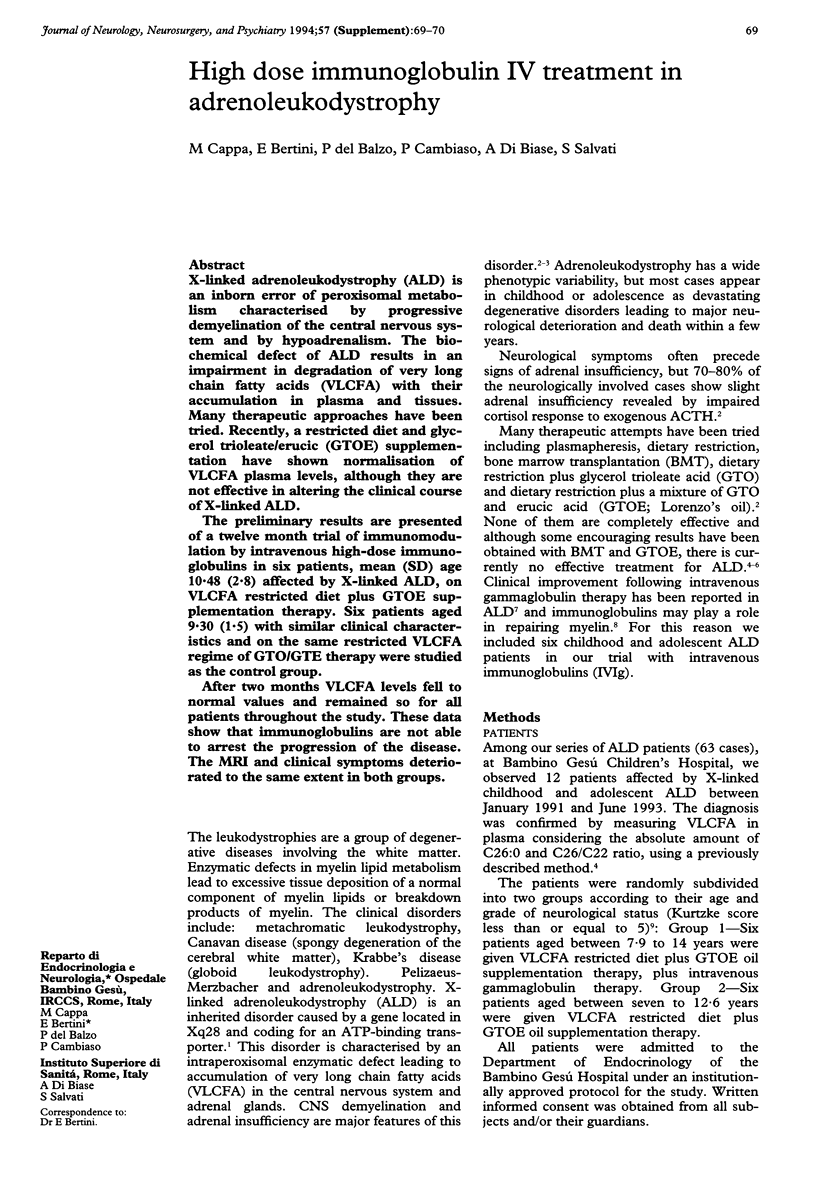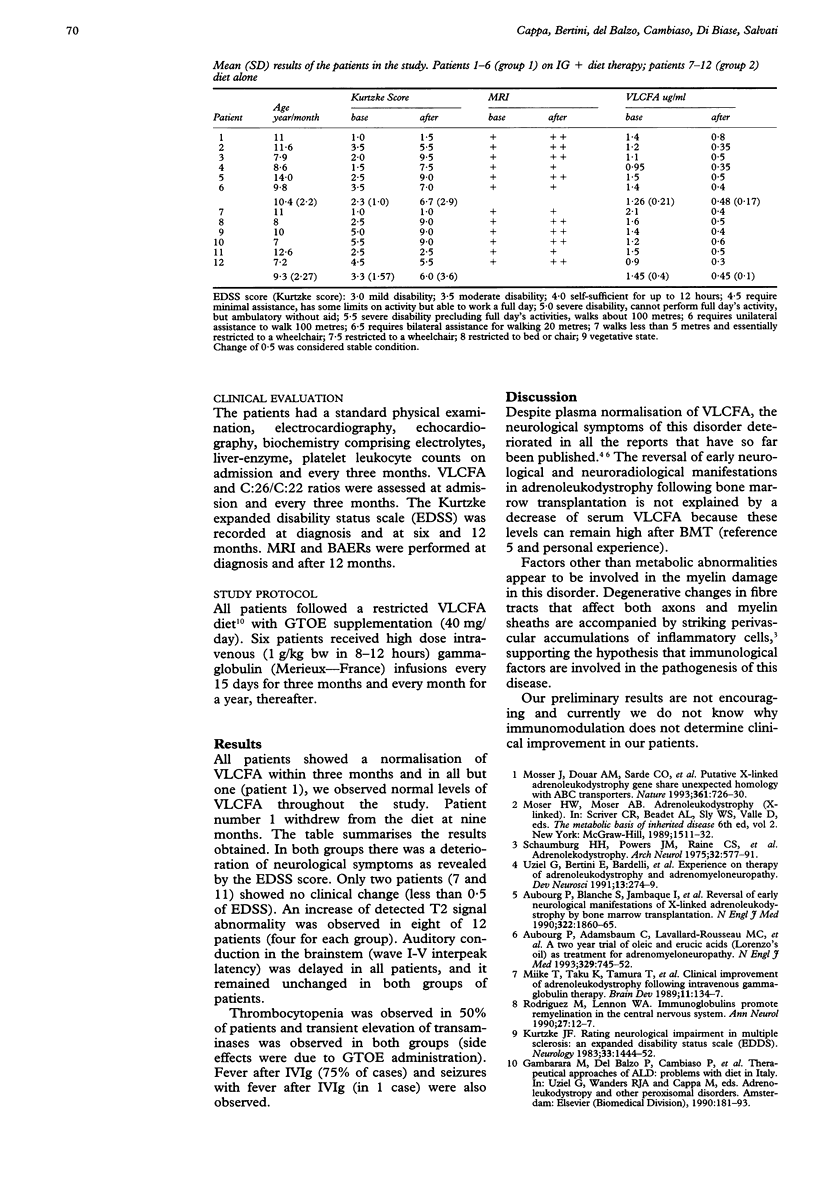Abstract
X-linked adrenoleukodystrophy (ALD) is an inborn error of peroxisomal metabolism characterised by progressive demyelination of the central nervous system and by hypoadrenalism. The biochemical defect of ALD results in an impairment in degradation of very long chain fatty acids (VLCFA) with their accumulation in plasma and tissues. Many therapeutic approaches have been tried. Recently, a restricted diet and glycerol trioleate/erucic (GTOE) supplementation have shown normalisation of VLCFA plasma levels, although they are not effective in altering the clinical course of X-linked ALD. The preliminary results are presented of a twelve month trial of immunomodulation by intravenous high-dose immunoglobulins in six patients, mean (SD) age 10.48 (2.8) affected by X-linked ALD, on VLCFA restricted diet plus GTOE supplementation therapy. Six patients aged 9.30 (1.5) with similar clinical characteristics and on the same restricted VLCFA regime of GTO/GTE therapy were studied as the control group. After two months VLCFA levels fell to normal values and remained so for all patients throughout the study. These data show that immunoglobulins are not able to arrest the progression of the disease. The MRI and clinical symptoms deteriorated to the same extent in both groups.
Full text
PDF

Selected References
These references are in PubMed. This may not be the complete list of references from this article.
- Aubourg P., Adamsbaum C., Lavallard-Rousseau M. C., Rocchiccioli F., Cartier N., Jambaqué I., Jakobezak C., Lemaitre A., Boureau F., Wolf C. A two-year trial of oleic and erucic acids ("Lorenzo's oil") as treatment for adrenomyeloneuropathy. N Engl J Med. 1993 Sep 9;329(11):745–752. doi: 10.1056/NEJM199309093291101. [DOI] [PubMed] [Google Scholar]
- Aubourg P., Blanche S., Jambaqué I., Rocchiccioli F., Kalifa G., Naud-Saudreau C., Rolland M. O., Debré M., Chaussain J. L., Griscelli C. Reversal of early neurologic and neuroradiologic manifestations of X-linked adrenoleukodystrophy by bone marrow transplantation. N Engl J Med. 1990 Jun 28;322(26):1860–1866. doi: 10.1056/NEJM199006283222607. [DOI] [PubMed] [Google Scholar]
- Kurtzke J. F. Rating neurologic impairment in multiple sclerosis: an expanded disability status scale (EDSS). Neurology. 1983 Nov;33(11):1444–1452. doi: 10.1212/wnl.33.11.1444. [DOI] [PubMed] [Google Scholar]
- Miike T., Taku K., Tamura T., Ohta J., Ozaki M., Yamamoto C., Sakai T., Antoku Y., Yadomi C. Clinical improvement of adrenoleukodystrophy following intravenous gammaglobulin therapy. Brain Dev. 1989;11(2):134–137. doi: 10.1016/s0387-7604(89)80083-x. [DOI] [PubMed] [Google Scholar]
- Mosser J., Douar A. M., Sarde C. O., Kioschis P., Feil R., Moser H., Poustka A. M., Mandel J. L., Aubourg P. Putative X-linked adrenoleukodystrophy gene shares unexpected homology with ABC transporters. Nature. 1993 Feb 25;361(6414):726–730. doi: 10.1038/361726a0. [DOI] [PubMed] [Google Scholar]
- Rodriguez M., Lennon V. A. Immunoglobulins promote remyelination in the central nervous system. Ann Neurol. 1990 Jan;27(1):12–17. doi: 10.1002/ana.410270104. [DOI] [PubMed] [Google Scholar]
- Schaumburg H. H., Powers J. M., Raine C. S., Suzuki K., Richardson E. P., Jr Adrenoleukodystrophy. A clinical and pathological study of 17 cases. Arch Neurol. 1975 Sep;32(9):577–591. doi: 10.1001/archneur.1975.00490510033001. [DOI] [PubMed] [Google Scholar]
- Uziel G., Bertini E., Bardelli P., Rimoldi M., Gambetti M. Experience on therapy of adrenoleukodystrophy and adrenomyeloneuropathy. Dev Neurosci. 1991;13(4-5):274–279. doi: 10.1159/000112173. [DOI] [PubMed] [Google Scholar]


